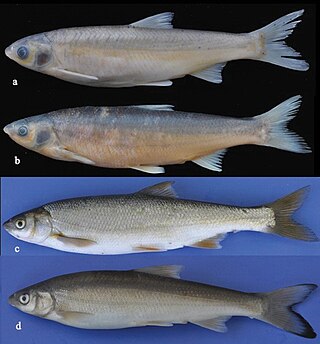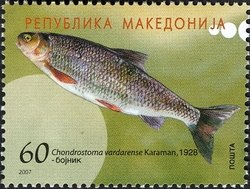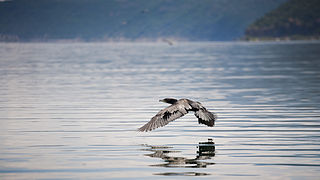
The Lake Prespa is located on the tripoint of North Macedonia, Albania and Greece. It is a system of two lakes separated by an isthmus: the Great Prespa Lake, divided between the three countries, and the Little Prespa Lake, mostly within Greece. They are the highest tectonic lakes in the Balkans, at an elevation of 853 metres (2,799 ft).

The common nase is a European potamodromous cyprinid fish. It is often simply called the nase, but that can refer to any species of its genus Chondrostoma. Another name is sneep.
Chondrostoma scodrense was a ray-finned fish that is classified as extinct by the IUCN Red List of Threatened Species.
Alburnus belvica. the Prespa bleak, is a species of ray-finned fish in the family Cyprinidae, that can be found in Lake Prespa and the nearby Small Prespa Lake in the Balkans. In North Macedonia it is known as nivichka (нивичка). It is threatened by habitat loss. This species makes up the bulk of the diet of the Dalmatian pelican population breeding at the Small Prespa Lake.
The Beysehir nase is a species of ray-finned fish in the family Cyprinidae. It is found only in Turkey and it is restricted to three streams flowing into Lake Beysehir, where it also occurs, in central Anatolia.

Chondrostoma kinzelbachi, commonly known as the Orontes nase or Levantine nase, is a species of nase, a genus of cypriniform fish within the cyprinid subfamily Leuciscinae. It is endemic to the Orontes River basin, historically occurring in Turkey and Syria. It is a fairly small freshwater fish, ranging from 11.8 centimetres (4.6 in) to 21.6 centimetres (8.5 in) SL.

The Neretvan nase or Dalmatian nase, Serbo-Croatian: podustva, is a species of freshwater fish in the family Cyprinidae. It is found in Bosnia and Herzegovina and Croatia.
Chondrostoma meandrense, sometimes called the Menderes nase or Işıklı nase, is a species of ray-finned fish in the family Cyprinidae. It is found only in Turkey. Its natural habitat is rivers. It is threatened by habitat loss.

The minnow-nase, Serbo-Croatian: podbila, is a species of freshwater fish in the family Cyprinidae. It is found in Bosnia and Herzegovina and Croatia. Its natural habitats are rivers, intermittent rivers, and inland karsts. It is threatened by habitat loss and considered Endangered (EN).

Chondrostoma soetta, or the Italian nase, is a species of freshwater fish in the family Cyprinidae. It is found in Italy, Slovenia, and Switzerland. Its natural habitats are rivers and freshwater lakes. It is threatened by habitat loss and predation and competition from introduced species such as roach, wels catfish and the common nase. It has been extirpated from Slovenia and numbers are declining in the Italian and Swiss lakes of Lake Como, Lake Lugano, Lake Maggiore, Lake Iseo and Lake Garda. Some population which are descended from fish introduced to other lakes in Italy appear to be thriving.

Chondrostoma vardarense is a species of ray-finned fish in the family Cyprinidae. It is found in Bulgaria, Greece, North Macedonia, and Turkey. Its natural habitat is rivers. It is threatened by habitat loss.
The Tefenni nase or Tefenni minnow is a species of ray-finned fish in the family Cyprinidae. It is found only in Turkey, where it has a distribution limited to the Kirkpinar spring in Karamusa village near Tefenni, Karatash Lake and Değirmendere stream flowing into Karamanlı Reservoir in wider Lake Burdur basin in Central Anatolia. Its natural habitats are rivers and intermittent rivers. It is threatened by habitat loss and was extirpated from the Kirkinpar spring, its type locality, and had to be reintroduced there with unknown success. The population in Değirmendere was discovered in the 21st century and its size is unknown.
The Prespa minnow is a species of ray-finned fish in the family Cyprinidae. It is found in Lake Prespa which lies in the southern Balkans on the borders between Albania, Greece, and North Macedonia. Its natural habitat is freshwater lakes. It is threatened by habitat loss.
Squalius prespensis is a species of freshwater fish in the family Cyprinidae, growing to 25 cm (9.8 in) SL. It was originally described as a subspecies of European chub.

Salmo peristericus, or the Prespa trout is a variety of trout, a freshwater fish in the family Salmonidae. It is endemic to the Lake Prespa watershed at the border area of Greece and North Macedonia.
The Volga undermouth or Volga nase is a species of cyprinid freshwater fish. This one lives in the Emba, Ural, and Volga drainages of the Caspian Sea basin and the Don River drainage of the Black Sea basin.
The fish fauna of the Neretva river basin in the western Balkans is representative of the Dinaric karst region and characterized by several endemic and endangered species.

For a small country, Albania is characterised by a considerable wealth of terrestrial and marine ecosystems and habitats with contrasting floral, faunal, and fungal species, defined in an area of 28,748 square kilometres. Most of the country is predominantly of Mediterranean character, comprehending the country's center and south, while the alpine affinity is more visible in the northeast.

Prespa National Park is a national park situated in southeastern Albania on the border triangle shared with Greece and North Macedonia. At approximately 277.5 km2 (107.1 sq mi), the park encompasses the country's sections of the Great and Small Prespa Lake. It is considerably characterised by high mountains, narrow islands, vast freshwater wetlands, salt marshes, meadows, reed beds and dense forests.

Over 22,500 species of wildlife have been recorded in North Macedonia. Over 10,000 of these are insects, which include 3,000 beetle species and large numbers of Lepidoptera, flies, and Hymenoptera. Aside from insects, other large arthropod groups include Chelicerata and crustaceans. Among vertebrates, more than 300 species of birds recorded, although not all nest in the country. There are over 80 species of both fish and mammals, 32 reptiles, and 14 amphibians.











